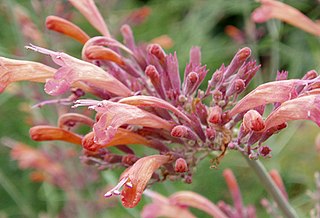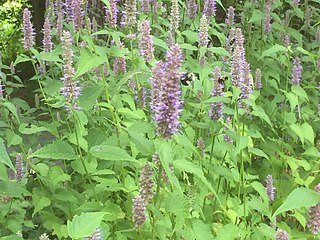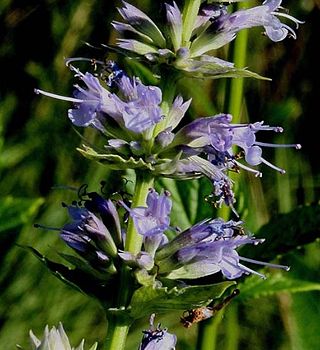
Hyssopus (hyssop) is a genus of herbaceous or semi-woody plants in the family Lamiaceae, native from the east Mediterranean to central Asia as far east as Mongolia. They are aromatic, with erect branched stems up to 60 cm long covered with fine hairs at the tips. The leaves are narrow oblong, 2–5 cm long. The small blue flowers are borne on the upper part of the branches during summer. By far the best-known species is the herb hyssop, widely cultivated outside its native area in the Mediterranean.

Monarda didyma, the crimson beebalm, scarlet beebalm, scarlet monarda, Eau-de-Cologne plant, Oswego tea, or bergamot, is an aromatic herb in the family Lamiaceae, native to eastern North America from Maine west to Ontario and Minnesota, and south to northern Georgia. Its odor is considered similar to that of the bergamot orange, which is used to flavor Earl Grey tea. The genus name comes from Nicolas Monardes, who described the first American flora in 1569.

Agastache is a genus of aromatic flowering herbaceous perennial plants in the family Lamiaceae. It contains 22 species, mainly native to North America, one species native to eastern Asia. The common names of the species are a variety of fairly ambiguous and confusing "hyssops" and "mints"; as a whole the genus is known as giant hyssops or hummingbird mints.

Mentha arvensis, the corn mint, field mint, or wild mint, is a species of flowering plant in the mint family Lamiaceae. It has a circumboreal distribution, being native to the temperate regions of Europe and western and central Asia, east to the Himalaya and eastern Siberia, and North America. Mentha canadensis, the related species, is also included in Mentha arvensis by some authors as two varieties, M. arvensis var. glabrata Fernald and M. arvensis var. piperascens Malinv. ex L. H. Bailey.

Agastache rugosa, also known as wrinkled giant hyssop, Korean mint, purple giant hyssop, Indian mint and Chinese patchouli is an aromatic herb in the mint family, native to East Asia.

Caulophyllum is a small genus of perennial herbs belonging to the family Berberidaceae and closely related to the Eurasian genera Leontice and Gymnospermium. It is native to eastern Asia and eastern North America. These plants are distinctive spring wildflowers, which grow in moist, rich woodland, it is known for its large triple-compound leaf, and large blue, berry-like fruits. Unlike many spring wildflowers, it is not an ephemeral plant and persists throughout much of the summer. Common names for plants in this genus include blue cohosh, squaw root, and papoose root. As hinted at by its common names, this plant is well known as an alternative medicine for inducing childbirth and menstrual flow; it is also considered a poisonous plant.

Asarum caudatum is a plant native to rich moist forests of western North America. It has heart-shaped leaves and a three-lobed purplish flower.

Prunella vulgaris, the common self-heal, heal-all, woundwort, heart-of-the-earth, carpenter's herb, brownwort or blue curls, is a herbaceous plant in the mint family Lamiaceae.

Agastache rupestris, known as the threadleaf giant hyssop, Mexican Hyssop, or licorice mint, is a wildflower of the mint family (Lamiaceae) native to the mountains of Arizona, New Mexico, and Chihuahua, Mexico. Popular in xeriscaping because of its heat tolerance and ability to thrive in dry, nutrient-poor soil, it is often planted in containers or as a border flower and used to attract hummingbirds. Displaying gray-green stems and leaves while dormant, its orange flowers with purple buds bloom from mid-summer until fall; if crushed the petals exude a pleasant scent.
Agastache parvifolia is a species of flowering plant in the mint family known by the common name small-leaf giant hyssop. It is endemic to far northern California, where it grows in woodlands. It is an uncommon species and is sometimes considered a local subspecies of Agastache urticifolia.

Hyssopus officinalis or hyssop is a shrub in the Lamiaceae or mint family native to Southern Europe, the Middle East, and the region surrounding the Caspian Sea. Due to its purported properties as an antiseptic, cough reliever, and expectorant, it has been used in traditional herbal medicine.

Agastache mexicana is a species of flowering plant in the mint family known by the common name Mexican giant hyssop. It is native to southern North America and can grow up to 100 cm tall. The leaves are lanceolate or oval-lanceolate. The plant is perennial and self-fertile. Its young lemon scented leaves are used in herbal teas and the leaves are also often used in flavoring foods.

Agastache foeniculum, commonly called anise hyssop, blue giant hyssop, Fragrant giant hyssop, or the lavender giant hyssop, is a species of perennial plant in the mint family, (Lamiaceae). This plant is native to much of north-central and northern North America, notably the Great Plains and other prairies. It is tolerant of deer and drought, and also attracts hummingbirds, butterflies, bumblebees, honey bees, carpenter bees, and night flying moths.
Agastache cusickii is a species of flowering plant in the mint family known by the common name Cusick's giant hyssop. It is native to the northwestern United States from eastern Oregon and central Nevada to Idaho and Montana.

Blephilia hirsuta is an herbaceous perennial of the mint family Lamiaceae native to eastern North America. It is commonly called hairy wood-mint or hairy pagoda plant.

Agastache cana, more commonly known as the mosquito plant, Texas hummingbird mint, and double bubble mint, is a hardy perennial belonging to the genus Agastache. The genus name Agastache is derived from the Greek word meaning "a lot of", and stachy, meaning "spike", which refers to the flower's 12 terminal spikes that decorate the plant. These spikes remain through the growing season from early summer to late fall. The Mosquito Plant is native to New Mexico and western Texas, where it grows in mountainous areas at altitudes of 6,000 feet.

Agastache pallidiflora, commonly known as New Mexico giant hyssop or Bill Williams Mountain giant hyssop, is a plant in the mint family.

Agastache scrophulariifolia, also known as the purple giant hyssop, is a perennial plant that grows throughout the US and Northern Ontario, CN. Its name comes from the similarity of its leaves to plants of the genus Scrophularia. It is a beneficial plant to pollinators and is noted for its medicinal properties, as many plants in the mint family are. It tends to grow in disturbed or open areas where it does not have to interact with non-native competitive plants.

Agastache nepetoides, commonly known as yellow giant hyssop, is a perennial flowering plant native to the central and eastern United States and Canada. It is a member of the Lamiaceae (mint) family.



















